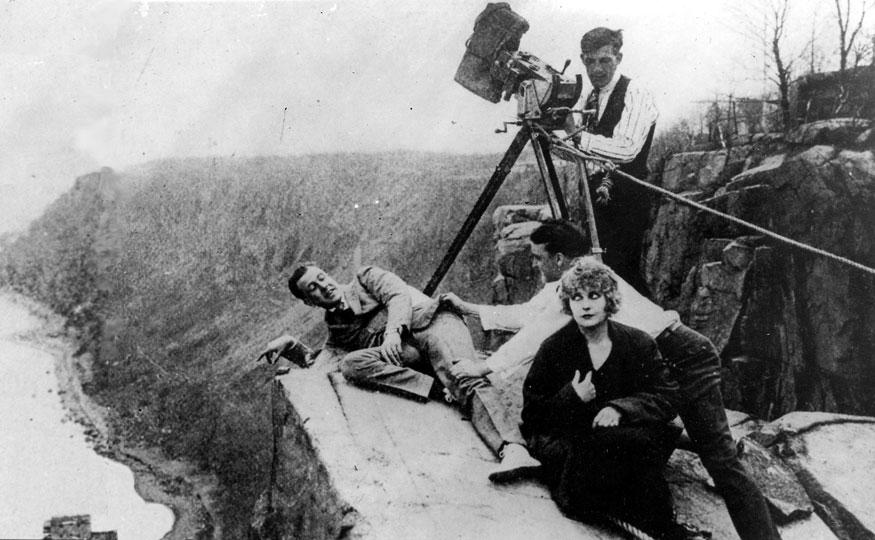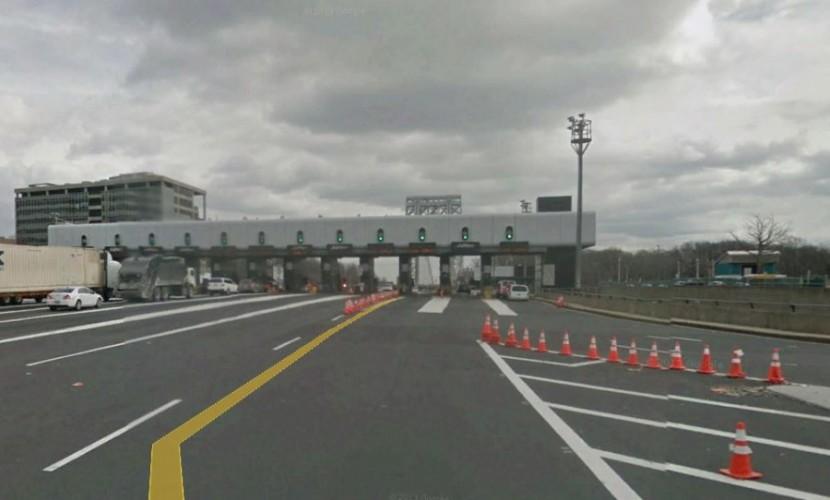Bridge-Gate – The Cliffhanger
The past few months have been a slowly unfolding whodunit turned into a blockbuster overnight on January 8, as emails were revealed to the press that directly linked Chris Christie’s staff to the growing Bridgegate scandal. At first blush when it happened, it was billed as a petty fairytale of political vengeance by a few that went awry and widened to ensnare an unwilling cast of thousands in the world’s first pre-Hollywood film town. Fort Lee.
The Scene
The dramatic backdrop for this story includes the breathtaking NJ Palisades along the picturesque Hudson River, overshadowed by what NJ residents consider the prettiest, as well as busiest, bridge in the world. Fort Lee was world famous long before the George Washington Bridge was even built, let alone thrust into the national spotlight because of Bridgegate.
Fort Lee was the movie making capital of the world before there even was a Hollywood, and home to one of the most famous amusement parks in the early 20th century - THE Palisades Amusement Park of both song and story. After the Bridge was built – with only one level (the second level would come decades later), Fort Lee would become even more glamorous than when the earliest westerns and the Perils of Pauline were filmed on its wooded lots and peopled by its local characters. Fort Lee was home to the famous Riviera Nightclub on the top of the Palisades, where Frank Sinatra regularly appeared, and which closed its doors for the last time 60 years ago this past New Year’s Eve, when the Fort Lee Film Commission commemorated the anniversary.
Big History
Although it has recently been called a “small town” by the national media, Fort Lee has a big history. That history extends back thousands of years to the formation of the Palisades, through Lenape occupation, Henry Hudson’s arrival, to the Revolutionary War, which is the main focus of the Fort Lee Historic Park. George Washington himself named Fort Lee and was forced to retreat from it causing Thomas Paine to write on his way across NJ “These are the times that try men’s souls.” Fort Lee was where Paine was stationed when Fort Washington across the river fell to the British. As the British scaled the Palisades north of Fort Lee to surprise Washington, Washington’s men – including Paine, literally ran for their lives, leaving fires burning and most of their supplies behind. They later saw victory at the Battle of Trenton, but the loss of Fort Lee on the NJ Palisades was a key event in the American Revolution which inspired a pamphlet called The American Crisis that would change the course of history. That event is commemorated every November by Revolutionary War re-enactors in Fort Lee.
“As I was with the troops at Fort Lee, and marched with them to the edge of Pennsylvania, I am well acquainted with many circumstances, which those who live at a distance know but little or nothing of.”
Thomas Paine – The American Crisis
Witness to 9/11
Centuries later, during September 11, 2001, the bridge, and the skyscrapers of Fort Lee were witness to the terrible events unfolding in Lower Manhattan. The Bridge itself was considered a major terrorist target and was closed as well as many of the roads leading to it – except for emergency vehicles who sped along the surrounding highways and entered Manhattan by the George Washington Bridge – using the local lanes in question. People were not even allowed to cross the bridge by bicycle that day.
In the days just after September 11, 2001, long before Governor Christie took office, the Bridge was considered a terrorist target and was protected and treated as such. The Port Authority employees that took care of running the bridge had seen colleagues die that day when the planes slammed into the building that housed their offices at the World Trade Center. The stunned coworker in Englewood Cliffs that informed me of the first plane crash used to work in the towers for the Port Authority. His former coworkers died that day. The George Washington Bridge was treated with respect and concern regarding Homeland Security for the past decade. Many of the veteran employees there take their jobs very seriously. At least up until the week of September 11, 2013.
The Plot
And so the town of Fort Lee, inspiration for the American Crisis by Thomas Paine, home to the famous Palisade Amusement Park and the Riviera nightclub that launched a thousand careers, and host to the world’s busiest bridge, was completely taken aback during the annual nervous week of September 11, 2013, when a politically engineered event turned their entire town into a parking lot. Someone at the Port Authority chose to suddenly shift two of the three toll lanes that normally accept 25% of the local flow through the upper levels of the George Washington Bridge, to the highway approaches. Without warning anyone. That simple act caused 600 car backups and prevented emergency vehicles from getting where they needed to go. It was the first day of school as well as Yom Kippur in addition to being the week of September 11, a grim anniversary for too many folks in Fort Lee many of whom live in high rise towers, who had experienced that horrible day first hand or had tragically lost loved ones or had just helplessly watched it from the Palisades.
For the week of the lane closures, a frantic Mayor Sokolich demanded answers from the Port Authority, as did Congressman Bill Pascrell. For many months after the lane closures, Senate Majority Leader Loretta Weinberg, and her legislative team whose district includes Fort Lee and the towns nearby that were also affected, demanded answers from the Port Authority of New York and New Jersey for the lane closures. Neither the Mayor nor the Senator or Assembly members Gordon Johnson and Valerie Vaineiri Huttle got any answers. And neither did the press. For months. The Port Authority – long considered a “Shadow Government” with little oversight had become a black box that no one could peer inside. It was a mystery wrapped in an enigma inside a riddle. Even the Commissioners remained mum. Every single one.
But then suddenly PA Deputy Executive Bill Baroni came up with a story that appeared to explain things, unless you are an engineer like me who got my start as an intern in the Bergen County Engineering Department Traffic Division – counting cars (I kid you not). Baroni called it a “traffic study” and brought a big picture of the toll lanes and drew on it at the meeting to illustrate his point. There was only one problem with the traffic study story. Traffic studies done by public agencies are never done that way. Not in Bergen County and not elsewhere. Traffic studies and traffic counts are sometimes done in person, but they are always purely observational. Lanes are never closed just to see what happens. That would be insane. According to the testimony of 30 year veterans Robert Durando and Cedric Fulton, traffic studies are never done that way at the Port Authority either. They have constant monitoring all the time. There is no need to physically change traffic patterns. The fact that no official traffic study data could actually be produced further cemented distrust of Baroni’s theory.
Wall Street Journal reporters landed the first big break in the story. Which gave everyone pause. This was the Wall Street Journal, not a “liberal” paper. Sources told the WSJ that David Wildstein had given the order for the lanes to be closed. Until that point, nobody knew who gave the order. The ice jam finally broke free and information started to flow Emails also showed that Port Authority Executive Director Patrick Foye, the New York Appointee, stopped the lane closures and admonished those who had closed them citing the danger and illegality of the closures. And so, after the Wall Street Journal scoop, the Transportation Committee was able with subpoena power to call Patrick Foye to testify along with the two employees called to carry out Wildstein’s order. The Assembly committee finally had some leads.
The expert testimony on December 9th, confirmed for the NJ Transportation Committee what I already knew. There was no real traffic study. But also something else – Robert Durando and Cedric Fulton were afraid of Governor Christie’s appointees. These two new revelations caused more subpoenas which resulted in an absolute treasure trove of documents that exploded onto the news Wednesday when the first ones to be released by The Record turned a possible fairy tale into an overnight blockbuster. It shook Christie to his very core and prompted a two hour press conference with Christie on the defensive for once. From the latest documents released we now know that the order to close the lanes came straight from Christie’s own staff. Foye calling an end to Wildstein’s order caused much consternation in the people who had closed the lanes, including Christie’ very TOP appointee at the Authority, Chairman David Samson, who was angry normal traffic flow was restored. Reference to a meeting between Samson and the Governor a week before Kelly gave the order to cause traffic problems in Fort Lee especially peaked Transportation Committee interest in finding out what was discussed at that meeting. Was that the infamous beginning of the dastardly plot? A plot that was adding characters at such an alarming pace that the news media was now creating cast lists so readers could keep up with the action.
During the testimony in early December by Durando and Fulton, it was also revealed that the police Captain Darcy Licorish (real but movie-sounding name) who had actually moved the cones was given a promotion shortly after the incident. That elicited commentary from Legislators on the transportation Committee that Captain Licorish had possibly been rewarded for silence. In addition, the Police Benevolent Association and Union head Paul Nunziato was also quoted in the WSJ that he had actually talked to Baroni about the three lanes and that he probably knew more than a traffic engineer. The most damning testimony came from Executive Director Patrick Foye, who seemed clearly upset by the lane closures and explained that there was no traffic study. The thorough discrediting of the traffic study theory by both traffic experts and the veterans of the PA in formal testimony made Chris Christie’s revived mention of the traffic study on January 8 sound odd to many elected officials listening to his apology. Especially in light of the fact that Mr. Baroni had resigned. If there had been a traffic study, then why would he resign?
The new mentions of Captain Licorish, and Paul Nunziato – who had been instrumental in supplying police union support for Chris Christie’s re-election, and Mr. Wildstein’s obvious involvement as well as Mr. Baroni’s, now called-into-question traffic study were the inspiration for the latest round of subpoenas.
At the same time these subpoenas were being served, the clock was ticking. On Tuesday Jan 14, the Transportation committee’s subpoena power runs out unless it is reinstated by the Assembly. There is now a race against time – which lends every good movie its action pace. Very Perils of Pauline. The incoming Assembly Speaker Prieto, a Christie ally, may not allow a vote to keep the investigation going. Wildstein and Baroni, by stalling, asking for more time, redacting much of the documents delivered, and by filing lawsuits to prevent Mr. Wildstein from testifying it is talking much longer to extract the truth. If subpeaona power runs out we may need to find out more by investigative reporters ala Woodward and Bernstein, or The Wall Street Journal and The Record.
The Smoking Gun
Based on the documents released Jan 8 by the Record, which revealed that Mr. Wildstein got the order directly from Chris Christie’s Deputy Chief of staff, Bridgette Kelly, it is now apparent that Mr. Wildstein knew ahead of time that there was a plan in place – which suggests conspiracy, and that more people were involved than just Mr. Wildstein (a heftier version of Woody Allen), who refused to talk unless he could be promised not to be prosecuted, since there appear to be laws broken in the lane closures. It was courtroom theater of the absurd but ultimately teased the Committee into thinking that perhaps, by sparing Wildstein going to jail, he would be willing to talk. It still appeared to many officials in the room that this was another stalling tactic to run out the subpoena power clock held by the Committee till January 14.
Patsy or Damsel in Distress?
Bridget Kelly. Several elected officials who know and have worked with Ms. Kelly feel that she is being unfairly thrown under the bus by the Governor, who did not even talk to her ( he stated that she lied to him – indirectly since Christie had his underlings do the questioning he spoke of during his soliloquy on Thursday), for giving an order (by email) she was told to give. Some newspaper reports mention the fact that Kelly is a divorced mom of four children, (one with a heart defect) with a hellish commute, implying she who may have been following orders to protect her job.
Traitors to the Left and Traitors to the Right
Thursday January 9, Governor Christie revealed that he had fired his Deputy Chief of Staff and his right hand campaign man Bill Stepien. While talking much more respectfully to reporters asking questions, by talking so long and so much, he opened up more opportunities and questions. He also evoked unfortunate shades of the Sopranos in his talk of “family” and “loyalty” and firing people not because they did terrible things to his constituents, but because they “lied” to him and betrayed him. In a politically historical remark right up there with “I am not a witch”, and “I am not a crook”, Governor Chris Christie explained to NJ, “I am not a bully”. His comment that he was “shocked” and the sincerity of that remark brought up many references to the film Casablanca. In a ridiculous twist and echo of September, there was again gridlock in Fort Lee – caused by the Governor coming to town during rush hour - to apologize to the Mayor in person.
The Paper Trail
As I write this elected officials in NJ and pundits in NY and across the country are poring over the documents released Friday. Theories are flying but still no real explanation of why this politically motivated traffic jam was caused in the first place. There are too many characters, too many theories and too much information to be covered in just one movie, or one blog for that matter. At first it appeared that it was payback for the Mayor not endorsing Governor Christie, then Rachel Maddow believed it was directed against Senator Weinberg for voting against Governor Christie’s choices for the Supreme Court. Now Steve Kornacki postulates that it has something to do with the 16 acre Billion (with a B) dollar construction project in Fort Lee. As in “Nice project you got going up there, would be a terrible thing if folks couldn’t get on the Bridge from it….”
In the Next Episode...
Like a cliffhanger that had its start in Fort Lee nearly 100 years ago to the day, when the Perils of Pauline was filmed right in Fort Lee, the first Movie Capital of the World, we have a genuine blockbuster taking up the news on nearly every channel as folks remain on the edge of their seats to see if the villains will get caught and if the innocent victims get justice.




